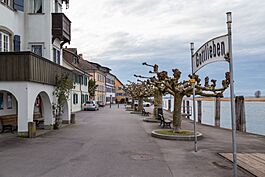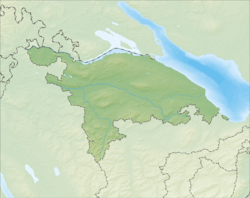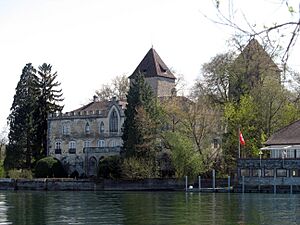Gottlieben facts for kids
Quick facts for kids
Gottlieben
|
||
|---|---|---|
 |
||
|
||
| Country | Switzerland | |
| Canton | Thurgau | |
| District | Kreuzlingen | |
| Area | ||
| • Total | 0.32 km2 (0.12 sq mi) | |
| Elevation | 400 m (1,300 ft) | |
| Population
(Dec 2020 )
|
||
| • Total | 337 | |
| • Density | 1,053/km2 (2,730/sq mi) | |
| Postal code |
8274
|
|
| Surrounded by | Constance (Konstanz) (DE-BW), Ermatingen, Reichenau (DE-BW), Tägerwilen | |
Gottlieben is a small town, also called a municipality, located in the Kreuzlingen area of the canton of Thurgau in Switzerland. It's a charming place with a rich history right by the Rhine River.
Contents
History of Gottlieben
Gottlieben was first mentioned around the end of the 900s. It used to be part of the land owned by the Bishop of Constance. In 1251, a castle was built in Gottlieben that became the home of the Bishops.
After the Swabian War in 1499, a special officer managed the village and its local court from the castle until 1798. This court covered Gottlieben and nearby villages like Engwilen, Siegershausen, and Tägerwilen. It was like a special area managed by the Bishop. The castle became private property in 1808 and was updated in a neo-Gothic style in 1837.
Gottlieben used to be part of the Tägerwilen church area. During the Protestant Reformation in 1529, people in Gottlieben changed to the new faith. A church was built in 1734-35, and Gottlieben got its own church area. Since 1912, it has been combined with Tägerwilen again.
In the 1600s and 1700s, Gottlieben grew a lot because it was a great spot for boats on the Rhine River. It became a busy place for trading salt, iron, and wine. In 1678, it even got the right to hold markets.
Even though some small factories, like a button factory, started in the 1800s, most people in Gottlieben worked in fishing, crafts, and trade until the mid-1900s. After 1945, tourism became the main industry. Today, only two boat yards and the famous Hüppenbäckerei restaurant remain from the older industries. In 2000, the Bodman-Haus, which was once the home of poet Emanuel von Bodman, opened as a memorial and cultural center.
Geography of Gottlieben
Gottlieben covers an area of about 0.33 square kilometers (0.13 square miles). About 15.2% of this land is used for farming, and another 15.2% is covered by forests. The largest part, 42.4%, is built up with buildings and roads. The remaining 36.4% is unproductive land, like natural vegetation.
The town is located in the Kreuzlingen district, northwest of Kreuzlingen. It sits right where the Rhine River flows into the Untersee part of Lake Constance.
Population and People
Gottlieben has a population of about 320 people. As of 2008, about 31.5% of the people living in Gottlieben were from other countries. Over the past ten years (1997–2007), the population has grown by about 6.8%.
Most people in Gottlieben speak German (93.1%). A smaller number speak Italian (1.3%) or Portuguese (1.3%).
In 2009, the age groups in Gottlieben were:
- Children (0-9 years): 7.8%
- Teenagers (10-19 years): 8.7%
- Young adults (20-29 years): 6.8%
- Adults (30-39 years): 11.3%
- Adults (40-49 years): 23.6%
- Adults (50-59 years): 17.8%
- Seniors (60-69 years): 12.9%
- Seniors (70-79 years): 8.1%
- Seniors (80-89 years): 1.9%
- Seniors (90+ years): 1.0%
In 2000, there were 133 households in Gottlieben, with an average of 2.1 people per household. Most homes were single-family houses (51.1%).
Important Buildings and Sites
The Gottlieben Castle is considered a very important heritage site in Switzerland. The entire village of Gottlieben, along with the nearby Untersee region, is part of the Inventory of Swiss Heritage Sites. This means they are special places that are protected for their historical and cultural value.
Economy and Jobs
In 2007, Gottlieben had a very low unemployment rate of 0.7%. Most jobs in Gottlieben are in the service sector, which includes things like tourism, restaurants, and other services. There are also some jobs in the secondary sector, which includes manufacturing and industry.
Many people who live in Gottlieben work outside the municipality. In 2000, about 50.9% of residents worked in other towns. However, 127 people also came into Gottlieben for work. Most people (53.7%) use a private car to get to work, while a smaller number (4.8%) use public transportation.
Religion in Gottlieben
Based on the 2000 census, about 28.6% of the people in Gottlieben were Roman Catholic, and 53.0% belonged to the Swiss Reformed Church. A small number of people belonged to other Christian churches or Islam. About 13.49% of the population did not belong to any church.
Education in Gottlieben
Switzerland generally has a very well-educated population. In Gottlieben, about 82.8% of adults (aged 25-64) have completed either high school or higher education, like university.
Gottlieben has its own primary school district called Götighofen. In the 2008/2009 school year, there were 52 students in total. This included 14 children in kindergarten and 38 children in primary school.
Images for kids
See also
 In Spanish: Gottlieben para niños
In Spanish: Gottlieben para niños









